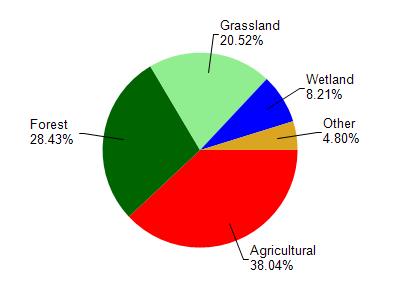Barron
Yes
Yes
No
Fish and Aquatic Life
Overview
Flowages on the Yellow River are shallow and highly eutrophc. The Yellow River drains to the
Red Cedar River. The upper portion of the Yellow River supports trout.
The model originally used for the watershed assessment provided estimates of sediment loading only
for upland fields. Models now available also allow the estimation of phosphorus loading, as well as
sediment loading, from these sites.
Jerome Foods Inc. has a surface water discharge from its aerated lagoon treatment system to the
Yellow River. Ths facility also discharges to groundwater through seepage cells. The reissued
permit will implement the phosphorus removal requirements of NR 217 Wis. Adm. Codes.
Northern Sofi Water operates a water softening business in Barron. When the permit application
and monitoring data are submitted for a discharge to the Yellow River, appropriate limitations will
be imposed to control chlorides and total dissolved solids in the discharge
Date 1996
Author Aquatic Biologist
Impaired Waters
Yellow River, from its mouth upstream to Barron Flowage No. 3 (miles 0 to 9.75), was evaluated for phosphorus and biology every two years between 2012 and 2018. Phosphorus levels were too high.
Yellow River, from Barron Flowage No. 3 to unnamed trib (WBIC 5005829) (miles 9.75 to 18.58), was evaluated every two-year cycle from 2018 to 2022; fish and bug data indicated a healthy system. This river segment is on the Healthy Waters List.
Yellow River, from unnamed trib (WBIC 5005829) to Jack Harrington Dam (miles 18.58 to 24.32), was evaluated in 2018 and 2022; fish data indicated a healthy system. This river segment is on the Healthy Waters List.
Yellow River, from Jack Harrington Dam to CTH B (miles 24.33 to 30.33), was evaluated every two-year cycle from 2018 to 2022; fish data indicated a healthy system. This river segment is on the Healthy Waters List.
Yellow River, from CTH B to Unnamed Trib (WBIC 5004991) (miles 30.33 to 34.94), was evaluated in the 2018 and 2022 cycles; fish data indicated a healthy system. This stream segment is on the Healthy Waters List.
Yellow River, from Unnamed Trib (WBIC 5004991) to Fox Lake (miles 34.94 to 36.58) and from Fox Lake to headwaters (miles 37.05 to 39.62) have not been evaluated for water quality.
Date 2022
Author Ashley Beranek
Condition
Wisconsin has over 84,000 miles of streams, 15,000 lakes and milllions of acres of wetlands. Assessing the condition of this vast amount of water is challenging. The state's water monitoring program uses a media-based, cross-program approach to analyze water condition. An updated monitoring strategy (2015-2020) is now available. Compliance with Clean Water Act fishable, swimmable standards are located in the Executive Summary of Water Condition in 2018. See also the 'monitoring and projects' tab.
Reports
Recommendations
Review, Update Use Designation
Trout water changed from Class I to a Class II water. Should evaluate issues related to NR102.
Management Goals
Wisconsin's Water Quality Standards provide qualitative and quantitative goals for waters that are protective of Fishable, Swimmable conditions [Learn more]. Waters that do not meet water quality standards are considered impaired and restoration actions are planned and carried out until the water is once again fishable and swimmable
Management goals can include creation or implementation of a Total Maximum Daily Load analysis, a Nine Key Element Plan, or other restoration work, education and outreach and more. If specific recommendations exist for this water, they will be displayed below online.
Monitoring
Monitoring the condition of a river, stream, or lake includes gathering physical, chemical, biological, and habitat data. Comprehensive studies often gather all these parameters in great detail, while lighter assessment events will involve sampling physical, chemical and biological data such as macroinvertebrates. Aquatic macroinvertebrates and fish communities integrate watershed or catchment condition, providing great insight into overall ecosystem health. Chemical and habitat parameters tell researchers more about human induced problems including contaminated runoff, point source dischargers, or habitat issues that foster or limit the potential of aquatic communities to thrive in a given area. Wisconsin's Water Monitoring Strategy was recenty updated.
Grants and Management Projects
Monitoring Projects
| WBIC | Official Waterbody Name | Station ID | Station Name | Earliest Fieldwork Date | Latest Fieldwork Date | View Station | View Data |
|---|
| 2096100 | Yellow River | 10011546 | Yellow River - Yellow River at 20 1/4 Ave | 10/2/1990 | 10/2/1990 | Map | Data |
| 2096100 | Yellow River | 10008081 | Yellow River | | | Map | Data |
| 2096100 | Yellow River | 10011449 | Yellow River at Foot Bridge | 1/1/2015 | 1/1/2015 | Map | Data |
| 2096100 | Yellow River | 10016311 | Yellow River - 3/4 Mile S. Of Hwy 48 On 12 1/2st. At Swale Confluence | 10/12/2000 | 10/12/2000 | Map | Data |
| 2096100 | Yellow River | 10012032 | Yellow River - Yellow River at 20 1/4 Ave | 1/1/2015 | 1/1/2015 | Map | Data |
| 2096100 | Yellow River | 033115 | Yellow River at 20 1/2 Ave N Yl2-T2 | 3/15/1990 | 4/4/1990 | Map | Data |
|

Watershed Characteristics
Yellow River is located in the Yellow River watershed which is 239.35 mi². Land use in the watershed is primarily agricultural (38%), forest (28.40%) and a mix of grassland (20.50%) and other uses (13.00%). This watershed has 415.31 stream miles, 2,929.80 lake acres and 11,565.29 wetland acres.
Nonpoint Source Characteristics
This watershed is ranked High for runoff impacts on streams, Not Available for runoff impacts on lakes and High for runoff impacts on groundwater and therefore has an overall rank of High. This value can be used in ranking the watershed or individual waterbodies for grant funding under state and county programs.However, all waters are affected by diffuse pollutant sources regardless of initial water quality. Applications for specific runoff projects under state or county grant programs may be pursued. For more information, go to surface water program grants.